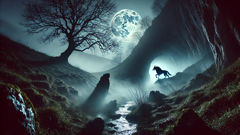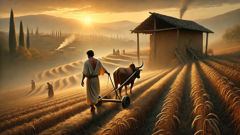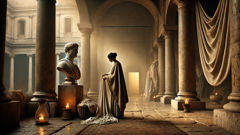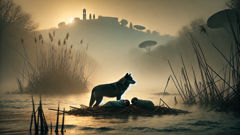Introduction
On the karst edges where limestone cliffs fracture into yawning mouths and the shepherds' songs die against stone, the people of the highland villages spoke in hushes of the Psoglav. A thing of contradiction — part man, part horse, head of a dog with iron teeth that rang like small bells when it gnawed bone — the Psoglav was thought to keep its lair in a cave with a narrow throat, beneath a ledge of overhanging rock and a single stunted oak. They said it emerged on nights when the moon slanted silver and thin as a sickle, padding down goat-tracks and through marshy hollows to hunt the foolish and the lonely. This story moves with footfalls: past the cobbled courtyards of a nameless village, through onion-scented smoke that drifts from chimneys, and into the cool breath of a cave where years have stacked themselves like bones. It tells how fear and ritual braided together, how the villagers learned to live with shadows, and how a single outlawed secret — a child's absence, a stolen calf, an unshriven debt — could loosen the hinge between the world of the home and the hollowed dark. My telling is faithful to the contours of that place and voice: not an encyclopedia entry but a long, close look, the sort of narrative a grandmother might murmur by lamplight when the wind lifts and the dog under the table pricks its ears.
Origins, Bones, and the Shape of Fear
The oldest stories about the Psoglav are not neat lineages but palimpsests, each telling layered over previous ones like soot on plaster. Elders in the mountain villages would sometimes hold more than one version in their heads: a cautionary tale for shepherds, a moral fable for unruly children, a memory of invaders who once rode with strange banners and stranger mounts. From the way the creature is described — the human torso, horse-like legs, and the unmistakably canine head with jaws of iron — scholars and storytellers alike trace a braided history that mixes Christian motifs, pre-Christian totems, and local responses to very human experiences: hunger, loss, and the rocky landscape that feels alive with its own intentions.
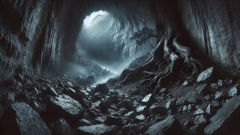
To understand the Psoglav, imagine a world where caves are not simply cavities in rock but mouths of the earth. In karst country, water carves secretive arteries beneath the surface, and caves appear like the belly of a beast. People of those places lived off what the land reluctantly offered: a thin crop here, a stubborn herd there. When a calf vanished overnight, or a shepherd failed to return from a distant pass, the explanations that comforted a grieving household were as practical as they were supernatural. Wolves could take a lamb; brigands could fetch a man away. But when loss clustered — calves disappearing, dogs torn, the soil being colder underfoot — then storytellers named the shape of it. Psoglav became the name for the pattern of absence and the risk that dark places embodied.
The iron teeth in particular are a detail that steadies the imagination. Iron is never a casual element in old stories; it is a metal that hums with usefulness and warding power. In peasant lore across the Balkans, iron holds a boundary function: horseshoes nailed to doorframes, knife blades hung above cradles, and iron coins hammered into roofs were tokens meant to halt restless spirits. That the Psoglav is said to possess iron teeth suggests both a monstrous inversion of a human tool and an intimate, terrible familiarity with the very things people trusted. Its teeth clink like small bells when it gnaws; the sound both warns and torments. Parents would hush their children and say, Do not stray near the hollow when you hear silver on rock, because the noise marks more than hunger — it marks memory.
Variations of the creature's form underscore how the image of the Psoglav changes with the telling. In one rendition, it is more dog than man, a heavy-jawed sentinel that patrols the threshold between grazing pasture and forest. In another, the torso is distinctly human, the gesture of shrugging or lifting a hand uncanny; maybe once human, the Psoglav hints, and now twisted. That ambiguity — between transformed human and born-animal — makes it a mirror. Do we fear what we were or what we could become? The horse legs place it among liminal things that cross terrains easily: it runs across fields and climbs up stony slopes where a pure dog might struggle. That mobility made it a harasser of caravans and night-watchers. For a lonely watchman bound to a narrow pass, the Psoglav's approach would be not just a threat to flesh but a reminder that isolation leaves you exposed.
Beyond the physical, the Psoglav takes shape as a vessel of social memory. Villages used its stories to teach boundaries — moral and spatial. Children were warned to avoid particular ravines and to return before dusk; lenders would use the name to shame the reckless; lovers whispering beneath a balcony might joke that the Psoglav has heard worse. A cautionary tale could quiet a rowdy evening and, perhaps more importantly, offer a ritualized release for communal anxieties. Where resources were scarce and injustice common, projecting blame into a monstrous figure could make blame less personal. When a family accused another of witchcraft or theft, a storyteller could divert the dispute with a tale of the Psoglav's appetite for pride, jealousy, and grudges. So the beast became an emblem of the things a community preferred to handle together rather than fight over.
Archaeology and comparative mythology point to wider affinities. Dog-headed figures appear sporadically through Eurasia — from the Egyptian god Anubis to scattered medieval marginalia — and while direct lines are hard to prove, the recurrence of canine imagery signals a deep human relationship with dogs as both helpers and border-keepers. Horses, too, carry symbolic weight: mobility, wealth, and martial capacity. By knitting dog and horse into a single fearful form, the Psoglav inherits a compound set of meanings: domestic loyalty gone feral, conveyance turned predatory, and the human body as both site of identity and raw material for fear. In the telling, it is often the community's collective memory — stories, songs, and warnings — that keeps the monster legible and therefore contained. Where the telling slips, the boundary frays.
The caves where the Psoglav was said to live are more than geography; they are infrastructure for story. Limestone caves in Serbia are full of sharp echoes, pinched passages, and pockets where the air tastes of iron and old water. A child who crawled in to fetch a lamb might find the light swallowed and the way out indistinct, giving primal theater to any sound — the drip of calcite, the scrape of a boot, the distant clatter of a farmer's chain. In the dark, a sheep's bleat becomes a human cry, and a scuff becomes claws. Caves also offered middens where bones accumulate, and people who stumbled on ancient bones could interpret them as evidence of a monstrous presence. Bones in a cave do not speak, but stories do, and when bones and story meet, they do remarkable work: they convince and confirm.
There is something else in the story of the Psoglav that resists simple rationalization: the way it binds particular nights and seasons to its appearances. Villagers recounted that the creature favoured the thin moon, the nights when fog lay like a damp cloth, and stretches of early autumn when the village stores were low and people's patience thin. Such specifics are not random; they function as mnemonic tools. When winter approaches and food is scarce, warnings proliferate — go not here, say not that — because practical survival benefits from caution. A mythic figure attached to a season acts like a calendar: take care now, mind your stores, look after your neighbors. The Psoglav story is, for all its blood and iron, a community-oriented caution: avert selfishness, uphold shared responsibilities, and keep the signals of the night clear.
In later centuries, as official religions and state authorities changed the lives of villagers, the creature's meaning adapted. Priests preached against superstitions; travelers from the cities wrote about “backwards” folk beliefs; collectors of folklore noted down terrified whispers in notebooks that smelled of damp ink. Yet the figure persisted. The power of a monster is not only in the thing itself but in the human need to name inexplicable cruelty. The Psoglav endures because it is at once a terrifying specter and a communal mnemonic for the precariousness of rural life among caves and cliffs.
It is no accident that the most vivid tales of the Psoglav center on particular families and transgressions. In one especially repeated version, a shepherd beats a stray dog that follows his flock. The dog, wounded and ashamed, disappears into the night. That winter, the shepherd's son disappears while playing near a cave mouth. The shepherd swears it is loss, bad luck. When a neighbor spies a dog-headed shadow at the cave entrance and hears the clink of metallic teeth, the shepherd realizes too late the kinship between violence done and consequence returned. The story is messy and punitive at once: it insists that cruelty — even if done by a man who frames it as necessary — be accounted for. Monsters in folklore do the ledger-keeping that a legal system might not. They hold grudges on behalf of the earth.
And yet the Psoglav is not only punitive. In some late reworkings, it becomes a guardian of the cave's secret: a monstrous sentinel who prevents deeper, older forces from crawling out. In those tellings, hunters who breach certain thresholds invite not only the Psoglav's wrath but also the surfacing of forgotten things: drowned tribes, warped trees, and slick, living mineral. The creature's ambivalence — at once predator and custodian — is a reminder that boundaries are not purely moral but ontological. Protecting them can be compassionate or cruel, depending on the day's bookkeeping.
By the time modern collectors wrote these tales down in neat, printed volumes, the image of the Psoglav had been polished into a set of motifs: cave, iron teeth, human torso, horse legs, and a moral about keeping to the paths. But those motifs are scaffolding, not the house itself. Beneath them lie human stories of grief, envy, love, and practical survival. The Psoglav’s real work is to hold all of that in one name so that, in the quiet between chores, villagers could name their unease and, perhaps, do something about it.
This is where old stories meet modern glance: not to flatten them into curiosities but to invite us to listen. The Psoglav’s teeth ring because they are tools for calling attention. The cave holds bones because those places collect memory. The night whispers warnings because living in precarious places requires stories like maps. If we step back and look at the legend as a living cultural practice, we find it both useful and human: a shared vocabulary for the things villagers could not control.
And so the origin of the Psoglav is less a single birth than a slow accretion. It grows in the gaps between what people can explain and what they cannot. It feeds on the same questions that produce songs, curses, and a neighborly hand when seeds run low. In every telling, it is the people in the village — their habits, their kindnesses, and their cruelties — that make the monster vivid. The Psoglav exists because people needed a name for the rough, ragged edge of the world.
A Night by the Hollow: A Village, a Shepherd, and the Cost of Silence
There was a particular autumn, the elders said, when the fog lay heavy like wool and the village's bread stores were low. That autumn we learn a useful, terrible lesson: fear becomes contagious if not named, and silence can be a hand that closes everyone in. In the story's longest version, the protagonist is not a bold hunter or a famous hero but a man named Jovan, a shepherd who knows the feel of his animals' breath and the count of his days by how many stars are visible on a clear night. Jovan is practical; he carries a lantern, he mends his boots, he does not much believe in monsters. But the village has a habit of telling children stories at the same time they rehearse social rules. Jovan's small cruelties — a harsh word, a stubborn refusal to forgive a debt, the beating of a stray dog that hangs around the fold — outline the human flaws that folklore loves to punish.

One evening, as a hard sky offered nothing but an oblique moon, the village's youngest boy, Marko, wandered closer to the cave than his elders allowed. He had been dared and distracted and had taken a small toy — a carved wooden horse — hidden beneath his shirt. The boy's games matter because children in these stories are not only the innocent victims but the living edge between play and danger. Marko is lured by a glimmer, or perhaps by the soft sound of paws on stone, and he slips toward the hollow. Jovan, passing by with a small flock, spares a scornful glance but does not call him back. He occupies the kind of moral middle ground that is common in folkloric narratives: neither hero nor villain, but accountable.
What follows is an evening narrated through sounds: the bleat of distant sheep, the chime of a cup in a neighbor's house, the metallic whisper of small teeth on stone. Marko does not immediately vanish; rather, he is noticed missing when the mother goes in to count heads. Panic slices in quick rounds — a search is organized, torches are lit, dogs are sent to bay at the edges. When the searchers reach the cave, they find a small wooden horse split in two and dragged some distance into the shadow, its grain pulverized. The boy is gone. The villagers blame wolves, then brigands, then the fickle hand of fate. But the legend insists on a more pointed account: someone, after all, had been cruel to a dog. Someone had failed to heed the rule to keep children from that hollow. They whisper the name Psoglav and the whisper, for a time, covers all other speech.
Jovan, who first refused to call Marko back, breaks at the news. He becomes a man undone by guilt, wandering into the dark with borrowed lanterns, pronouncing apologies to the bone and the wind. He tries to bargain — to leave meat at the cave's mouth, to hang iron trinkets on the oak root, to bore holes in the rock and pour wine into them as an offering. The rituals are part supplication, part superstition, and they are offered with the hope that the world will relent. But ritual, the story suggests, cannot always undo prior harms. The Psoglav, if it is a ledger, keeps its accounts strict.
At last, an elder woman who has seen more winters than most takes a different approach. Her name in the tale is Mara; she has a voice like scissored cloth and a patience that is a little frightening. Mara sits with Jovan and with the grieving mother and says simply: we must change our busyness. She speaks not of fear but of practice: keep watch in pairs, feed the strays, name aloud the missing. She teaches a song that is half prayer and half roll-call, a melody meant to call people together instead of scattering them. This intervention is the heart of the folktale's social teaching: monsters often thrive in isolation, whether of children or of adults. Communal practices — practical, ritual, and musical — are the remedy. When the villagers adopt this, when they stop leaving the watch to single men and begin to take turns, when they put iron at doorways yet also feed the poor, the nights become less hungry.
But the story resists tidy resolution. Even after the communal adjustments, the cave remains a place of appetite. Years later, someone else comes too close. An old feud flares. A traveling merchant who insults a widow's son is found days later dead on a stony ledge. The villagers tell themselves cautionary rationalizations, but some nights the hollow still whispers. The Psoglav, the tale suggests, does not vanish because people are more generous. Rather, its existence continues as a test: will the community remember its obligations or will it slip back into small cruelties that invite catastrophe? The narrative therefore functions as both explanation and injunction: it explains misfortune as the consequence of social fracture and it enjoins people to mend those fractures.
The story's texture — precise: the tang of stale beer, the scratch of wool, the low moan of wind through reed — makes it feel real and enduring. The Psoglav itself appears not always as a solo predator but sometimes as a rumor with pieces that fit into many hands. Pistons of iron teeth and clinking bones are metaphors for the sharpness of conscience. Animal forms are metaphors for human habits. They make the tale flexible enough to be told around kitchen fires and in the hush of newlywed warnings. The legend offers both theater and policy: it is entertainment that doubles as an oral governance system.
As the story spreads beyond the village, the Psoglav becomes a subject of curiosity for travelers and collectors. A nineteenth-century outsider might record the creature's image and attribute it to a primitive belief system, while a visiting poet might take the iron teeth and turn them into a famous line in a longer verse about borderlands between life and death. No matter the interpreter, those whose lives are actually lived at the margins — shepherds, housewives, traders — retain the version that works for them: practical, stern, and operative. They keep the verse about iron teeth because, in days when iron nails and iron knowledge are scarce, something that glints and bites demands attention.
There are also tales that grant mercy. In some local variants, the Psoglav is appeased not by blood but by remembrance. A family that once lost a child might, each year, leave a bowl of porridge at the hollow and speak the child's name aloud. The ritual is less about placating a monster than about refusing to forget. Naming the absent re-anchors the community to its responsibilities. If the Psoglav is ever a teacher, it teaches memory: remember the living, remember the dead, remember obligations. That, more than iron teeth, is what keeps a place together.
In modern times, the Psoglav’s story takes on new shapes. Tour guides might mention it with a chuckle; poets might lift its image as emblematic of hard land. Anthropologists write essays about boundary-figures in agrarian societies. Yet in the telling that matters most — the one that keeps people alert to one another — the Psoglav remains a living instrument: a story for shepherds, a warning for children, a leverage point for neighbors to demand decency. It is a small secular theology of care, disguised as a monster tale.
The cautionary arc of Jovan, Marko, and Mara is not a parable that concludes with tidy morality. Instead it stretches forward as an extended test: will a people keep watch over the weak, feed the poor, and correct their cruelties? Or will they revert to small selfishnesses that invite the world's teeth? The ending of the story, on the lips of different tellers, changes. Sometimes Marko is found, a little sadder and wiser; sometimes he is not. Either way, the narrative leaves behind practices: community watches, songs, iron hung over doors, and stories that insist on attention. That persistence is the most human part of the tale: we are creatures who ward ourselves against darkness by telling each other what to watch for.
Conclusion
Legends like the Psoglav endure because they do something practical with fear: they name it, herd it into patterns, and set rules for living so that communities may survive the nights. The dog-headed figure with iron teeth is both a monster to be feared and a mirror to human values; it reflects the ways we treat one another, how we care for children, and whether we keep watch in pairs rather than leaving the weak alone. From the mouth of a cave to the circle of a hearth, the Psoglav's story stitches together responsibilities and memory. Its iron teeth ring not only as a harbinger of danger but as a summons to recall the obligations that make communal life possible. Whether viewed as a relic of pre-Christian myth, a cautionary tale born of hunger and scarcity, or a living piece of cultural practice, the Psoglav remains eloquent: monsters are often metaphors, and the real work of folklore is not to terrify for terror's sake but to teach us how to live together at the edge of things. In that sense, the hollow will keep calling and the villagers will keep answering, and in the exchange between cave and community, something durable — memory, ritual, and, occasionally, the rescue of a lost child — is sustained.

